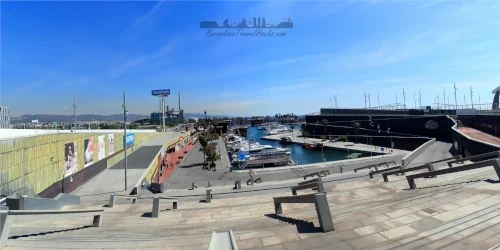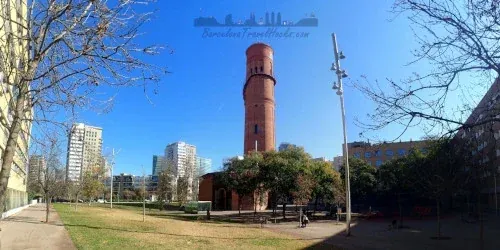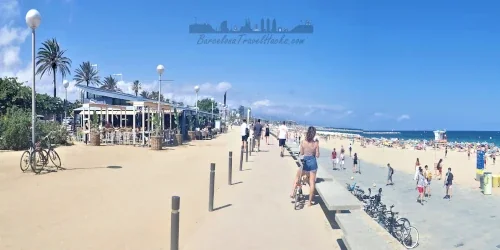Barcelona Natural Sciences Museum - Museo Ciències Naturales
Barcelona Museu Blau el Forum. Discover planet earth from creation to today's life on earth in a child friendly, informative & interactive space
About Barcelona Natural Sciences Museum
Barcelona's Natural Sciences Museum, Museo de Ciències Naturales de Barcelona, is locally known as the Blue Museum, Museu Blau because it relocated from the Three Dragons Castle to the distinctive Herzog & de Meuron's bluebery cake slice shaped building in the Forum area of Barcelona in 2010. The museum opened a year later in 2011.
Inside the blue coloured triangular building is a collection of artefacts that chart the history of planet earth from the Big Bang to current day. The museum tackles complex natural science theories such as evolution, species classification, plant and fungus life, viruses and bacteria, the big bang, mineralogy and much more, in an interactive child friendly environment that is engaging for for all ages.
Museo de Ciències Naturales de Barcelona has two sites, The forum Blue building and the Barcelona Jardí Botànic in Montjuïc.
- 1878: The naturalist Francesc Martorell i Peña left his extensive collection of exhibits to the city laying the foundation stone for the Association of Natural Science Museums in Barcelona.
- 1917: The Three Dragons Castle building is handed over to the Museo Martorell de Arqueología y Ciencias Naturales who opened a natural sciences museum in Barcelona.
- 2004: Architects Herzog & de Meuron construct the Blue building in Forum.
- 2010: The Three Dragons castle closes and the Natural sciences museum moves to a new building in Forum.
- 2011: Museo de Ciències Naturales de Barcelona Reopens in the new Forum building.
Barcelona Natural Sciences Museum History
Image Gallery for Barcelona Natural Sciences Museum
Click on any of the 74 images to open full screen gallery player
Visiting Barcelona Natural Sciences Museum
As you enter the building you walk up stairs with an overhanging whale skeleton. After buying a ticket in reception you pass the lockers area and enter a display about the history of the museum. From here you can also look down onto the whale skeleton.
The actual museum begins when you enter a zone with dim lighting which has a giant multi media display of planet earth. Here you will learn about the big bang and continental shift of the plates that make up the earth's surface. after the globe display the route continues into a blue lit corridor with rocks and fossils that are millions of years old. For each important period of Earth's development, you can use touchscreens to retrieve more interesting information about the different epochs or specific exhibits.
The next section is a large collection of animal and bug fossils as well as a room about Human evolution. The evolution room contains a replica of Lucy, the well-known skeleton of a pre-human Australopithecus afarensis, which was found in 1974 in Ethiopia. You will see a prognathodon stadtmani kass skeleton (jurasic sea creature) hanging from the ceiling. There is a collection of large shells and an explanation of symmetry in nature as well as the identifying characteristics of animal cells.
After this is the collection that came from the original science museum in Three Dragons Castle. it is a zone of large glass displays with stuffed animals, including a lion, gorilla and many birds. When I visited this museum in Three Dragons Castle (pre 2010) this collection was displayed in a wooden panelled room which was a little bit creepy. The new museum in Forum uses lighting to make this section more educational and not at all creepy.
After this the museum leads into a flora and fauna exhibition from the tiny microbe to mushrooms, trees, plants and an explanation of plant cell structure. In this zone you will find an interactive room about bio diversity and a focus on the Catalonia region of Spain. The exhibition also illustrates the responsibility that humans have for the preservation of the environment and nature.
The last theme of the museum is mineralogy, the crystal structures and different types of rocks that can be found on earth.
- The museum is child friendly and next to Barcelona beaches. and the Forum Port and beach.
- The building architecture and interior lighting make the exhibits more engaging for the whole family.
- Gain an understanding of the diversity of life on planet earth.
- It is free entry all day on the first Sunday of the month.
why visit Barcelona Natural Sciences Museum
Barcelona Natural Sciences Museum Tickets
Adult entry costs 6.00 euros with discounts for seniors, students and children. Tickets can be purchased through the Barcelona Natural Sciences Museum Website.
If you are planning to visit multiple museums and attractions during your visit to Barcelona, Consider the Barcelona Card which has 25 museums and attractions included in the bundle, including the Barcelona Natural Sciences Museum.
- Winter (October to February):
- Tuesday to Friday: 10:00h to 17:00h
- Saturday: 10:00h to 19:00h
- Sunday & public holidays: 10:00h to 20:00h
- Summer (March to September):
- Tuesday to Saturday: 10:00h to 19:00h
- Sunday & public holidays: 10:00h to 20:00h
- Closed: Mondays, 1st January, 1st May, 24th June, 25th December
Barcelona Natural Sciences Museum Opening Hours
What to take with you for Barcelona Natural Sciences Museum
Access to the museum is permitted with guide dogs and there is tactile paving to access the information point. The museum has lift access and a wheelchair is available for visitors. Throughout the building there are adapted toilets.
Use the lockers to store bags rather than carry them around. A 50 cent or 1 euro coin will release the key. However when I visited I asked for change and was given a 1 euro coin shaped washer!
Bicycle anchorage can be found in front of the museum in Passeig de Taulat.
Barcelona Natural Sciences Museum Summary of Prices
Getting to Barcelona Natural Sciences Museum
Address: Plaça Leonardo Da Vinci, Barcelona. 08019
- TMB metro yellow (L4) line El Maresme Forum stop
- Fòrum Tram stop on the T4 & T6 lines
Use a T-Casual or Hola-Barcelona travel card for metro, Tram and bus services.
Documents for Barcelona Natural Sciences Museum
Click on any one of the 1 PDFs to view in full screen and download.
Map of Barcelona Natural Sciences Museum
Weather for Barcelona
Where to stay overnight in the Barcelona Natural Sciences Museum
Things to do near Barcelona Natural Sciences Museum
 METRO
METROExploring Port Forum & Parc Litoral on foot and jet-ski
A 1992 Barcelona Olympic port with secret beach nearby that has views of the futuristic power plant behind. Explore on foot and rent a jet-ski
Read more >
 METRO
METROBesòs Water Tower - Torre de les Aigües del Besòs
A historic modernist industrial brick landmark in the Poblenou and Fòrum neighbourhoods & a beautiful example of water infrastructure in Catalonia
Read more >
 METRO
METRO